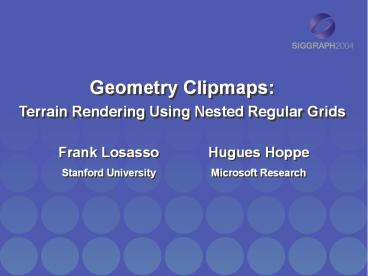Geometry Clipmaps: Terrain Rendering Using Nested Regular Grids - PowerPoint PPT Presentation
Title:
Geometry Clipmaps: Terrain Rendering Using Nested Regular Grids
Description:
Geometry Clipmaps: Terrain Rendering Using Nested Regular Grids Frank Losasso Stanford University Hugues Hoppe Microsoft Research Terrain Rendering Challenges Concise ... – PowerPoint PPT presentation
Number of Views:147
Avg rating:3.0/5.0
Title: Geometry Clipmaps: Terrain Rendering Using Nested Regular Grids
1
Geometry ClipmapsTerrain Rendering Using Nested
Regular Grids
Frank Losasso Stanford University
Hugues Hoppe Microsoft Research
2
Terrain Rendering Challenges
Mount Rainier
Primary Dataset United States at 30m spacing20
Billion samples
Olympic Mountains
- Concise storage ? No paging hick-ups
- Real-Time frame rates ? 60 fps
- Visual continuity ? No temporal pops
3
Previous Work
- Irregular Meshes (e.g. Hoppe 98)
- Fewest polygons
- Extremely CPU intensive
- Bin-trees (e.g. Lindstrom et al 96)
- Simpler data structures / algorithms
- Still CPU intensive
- Bin-tree Regions (e.g. Cignoni et al 03)
- Precomputed regions ? Decreased CPU cost
- Temporal continuity difficult
4
Previous Work
- Texture Clipmaps Tanner 1998
- Infinitely large textures
- Clipped mipmap hierarchy
- Modeling for the Plausible Emulation of Large
Worlds Dollins 2002 - Quadtree LOD around viewer
- Terrain synthesis
5
Geometry Clipmaps
- Store data in uniform 2D grids
- Level-of-Detail from nesting of grids
- Refine based on distance
- Main Advantages
- Simplicity
- Compression
- Synthesis
6
Terrain as a Pyramid
- Terrain as mipmap pyramid
- LOD using nested grids
Coarsest Level
Finest Level
7
Puget Sound
8
Individual Clipmap Levels
- Uniform 2D grid
- Indexed triangle strip
- Efficient caching
- 60 M triangles/second
- 255-by-255 grid
- Expected Soon
- Vertex Textures
9
Inter-Level Transitions
- Between respective power-of-2 grids
10
Inter-Level Transitions
No transition
Geometry transition
Geometry texture transition
Gaps in geometry
Gaps in texturing/shading
11
Inter-Level Transitions
- Vertex shader ? blend geometry
- Pixel shader ? blend textures
- Both are inexpensive
12
Clipmap Update
- For each level
- Calculate new clipmap region
- Fill new L-shaped region
- Use toroidal arrays for efficiency
13
Clipmap Update
- Update levels coarse-to-fine
- Use limited update budget
- Only render updated data
- Fine levels may be cropped
- Rendering load decreases as update load becomes
to large for the budget
14
Filling New Regions
- Two Sources
- Computed on-demand ? at 60 frames/second
Decompressed explicit terrain
Synthesized new terrain
15
Clipmap Update
- Fine level from coarse level
- U is a 16 point C1 smooth interpolant
- For synthesized terrain, X Gaussian noise
- For explicit terrain, X compression residual
16
Terrain Synthesis
- Adds high frequency detail
- Upsample then add Gaussian noise
- Precomputed 50-by-50 noise texture
- Per-octave amplitude from real terrain
17
Texture Synthesis
18
Subdivision Interpolant
Bilinear Interpolant (C0)
16-point Interpolant (C1)
19
Terrain Compression
- Create mipmap fine-to-coarse
- D found from data such that
20
Terrain Compression
- Calculate residuals coarse-to-fine
- Upsample and compute inter-level residual
- Quantize and compress residual
- Replace approximation
- ? Prevent error accumulation
21
Compression Results
- U.S height map
- 30m horizontal spacing
- 1m vertical resolution
- 216,000-by-93,600 grid
- 40GB uncompressed
- 350MB compressed ? factor of over 100
- rms error 1.8m (6 of sample spacing)
22
Compression Results
LOD scheme Number of samples Runtime space Bytes per sample
Hoppe 98 8 M 50 MB 6.0
Lindstrom 02 256 M 5.0 GB 19.5
Cignoni et al 02 64 M 115 MB 1.8
Geometry Clipmaps 20 G 375 MB 0.02
23
Level-of-detail Error
- Analyzed statistically ? See paper
- For U.S. terrain (640-by-480 resolution)
- rms error 0.15 pixels
- max error 12 pixels
- 99.9th percentile 0.90 pixels
24
United States of America
25
Graphics Hardware Friendly
- Can be implemented in hardware
- Clipmap levels as high-precision textures
- Subdivision and normal calculation Losasso et al
03 - Morphing already done in hardware
- Noise from Noise() or from texture
- Uploaded on-demand
- Decompressed terrain
26
Limitations
- Statistical error analysis
- Assumes bounded spectral density
- Unnecessarily many triangles
- Assumes uniformly detailed terrain
- but, allows for optimal rendering throughput
27
Advantages
- Simplicity
- Optimal rendering throughput
- Visual continuity
- Steady rendering
- Graceful degradation
- Compression
- Synthesis































